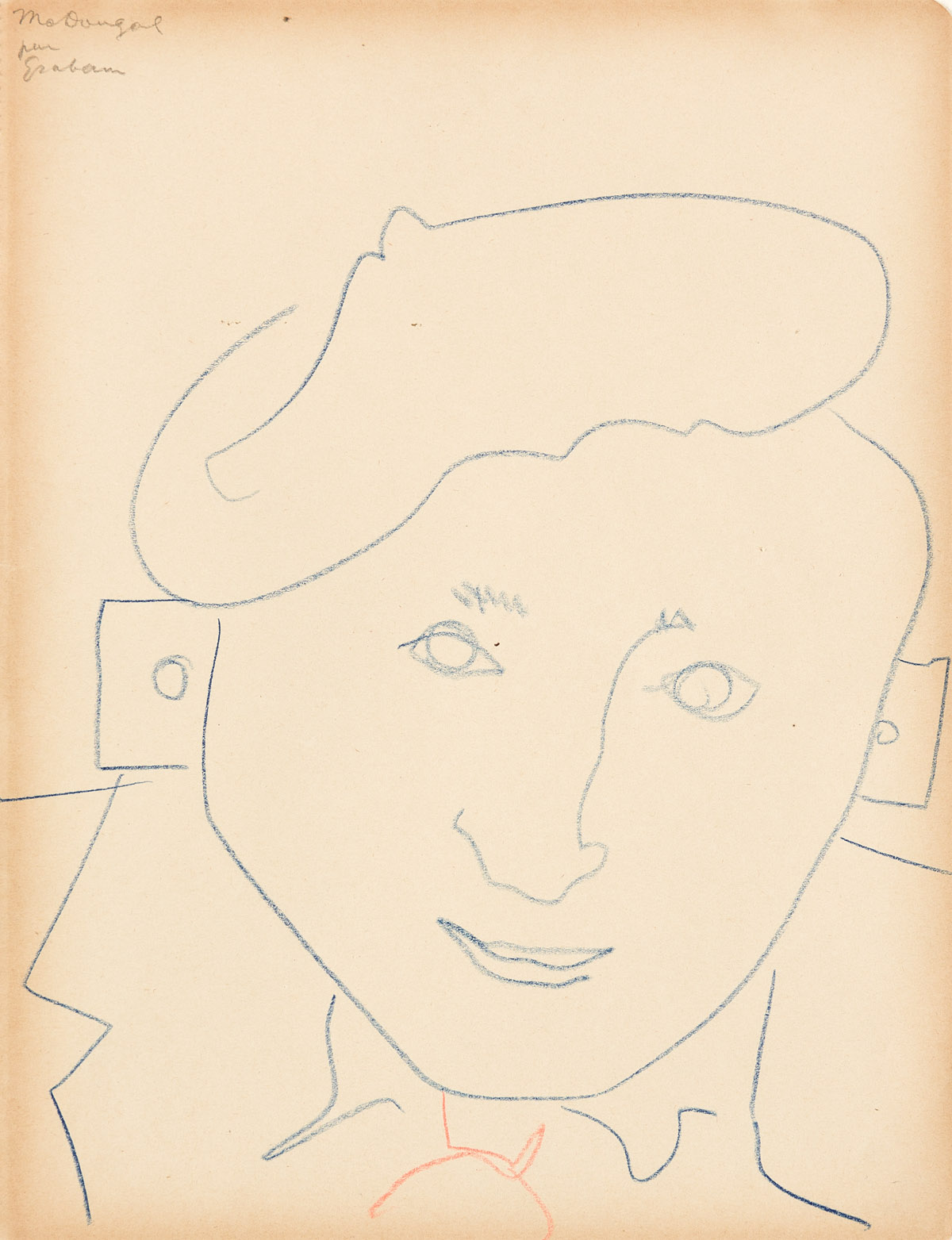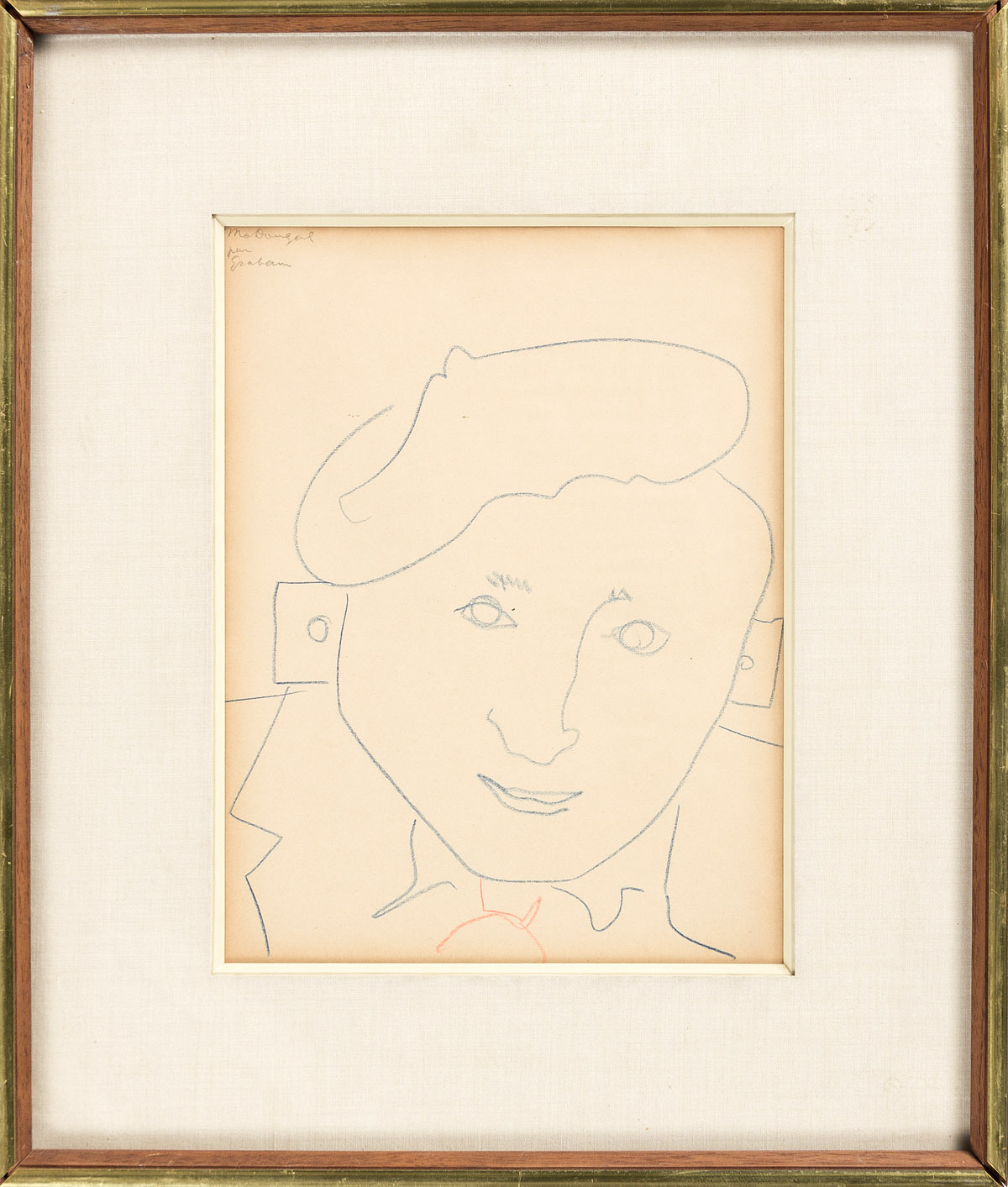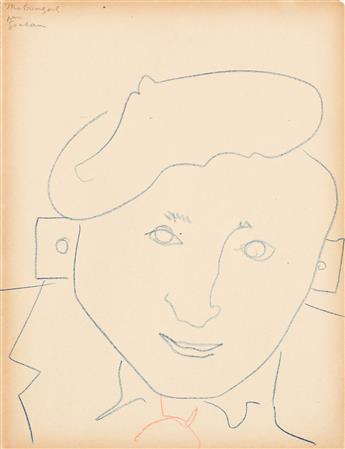Sale 2614 - Lot 113
Unsold
Estimate: $ 1,000 - $ 1,500
JOHN GRAHAM
Portrait of McDougal.
Color crayons on cream wove notepaper, circa 1929. 270x210 mm; 10 5/8x8 1/8 inches. Signed and titled in pencil, upper left recto.
Provenance: Zabriskie Gallery, New York, with the label; private collection, New York.
Graham's significant, influential career of four decades was marked by reinvention and a commitment to his vision of the endless possibilities of American Art.
Born Ivan Dabrowsky in Kiev, Graham was a law student and a czarist soldier in the 1917 revolution. After imprisonment and the downfall of Nicholas II, Graham left Russia and arrived in the United States in 1920. Though it is unclear if he showed artistic inclination in Russia, Graham recreated himself as an art student in New York. He attended the Art Students League from 1922 to 1924, where he studied under John Sloan (1871-1951). In a meteoric rise to recognition, Graham's first solo museum exhibition was organized by Duncan Philips in 1929.
Like many early career artists, Graham traveled to Paris and he came under the influence of the Surrealists and their psychoanalytical approach, however he remained dedicated to his mission of creating a new American Art. Along with Stuart Davis (1892-1964) and Arshile Gorky (1904-1948), Graham would provide a foundation for American Modernism and would be sought out by a new generation of the New York School (his watershed 1937 treatise, System and Dialectics of Art had advanced the Abstract Expressionist movement).
During the 1940s, Graham departed from his post-Cubist style, and adopted a new loosened, abstract style. At this time, he served as a mentor to younger artists such as Jackson Pollock, Willem de Kooning and Arshile Gorky, whose works would shape the Abstract Expressionist movement. Graham was also considered influential to Lee Krasner, David Smith, Dorothy Dehner, and Mark Rothko.
In his mature career, he found inspiration in Old Master works and he approached his canvases with a measure of dignity and mysticism. His portraits are powerful, standing out boldly from their flattened back drops. Simultaneously, Graham conveyed a delicate luminosity and vulnerability; his courtesans' askew eyes act to ground the figure in a plane between fantasy and reality. This merging of worlds characterizes not only Graham's work but also his storied, monumental life.
Portrait of McDougal.
Color crayons on cream wove notepaper, circa 1929. 270x210 mm; 10 5/8x8 1/8 inches. Signed and titled in pencil, upper left recto.
Provenance: Zabriskie Gallery, New York, with the label; private collection, New York.
Graham's significant, influential career of four decades was marked by reinvention and a commitment to his vision of the endless possibilities of American Art.
Born Ivan Dabrowsky in Kiev, Graham was a law student and a czarist soldier in the 1917 revolution. After imprisonment and the downfall of Nicholas II, Graham left Russia and arrived in the United States in 1920. Though it is unclear if he showed artistic inclination in Russia, Graham recreated himself as an art student in New York. He attended the Art Students League from 1922 to 1924, where he studied under John Sloan (1871-1951). In a meteoric rise to recognition, Graham's first solo museum exhibition was organized by Duncan Philips in 1929.
Like many early career artists, Graham traveled to Paris and he came under the influence of the Surrealists and their psychoanalytical approach, however he remained dedicated to his mission of creating a new American Art. Along with Stuart Davis (1892-1964) and Arshile Gorky (1904-1948), Graham would provide a foundation for American Modernism and would be sought out by a new generation of the New York School (his watershed 1937 treatise, System and Dialectics of Art had advanced the Abstract Expressionist movement).
During the 1940s, Graham departed from his post-Cubist style, and adopted a new loosened, abstract style. At this time, he served as a mentor to younger artists such as Jackson Pollock, Willem de Kooning and Arshile Gorky, whose works would shape the Abstract Expressionist movement. Graham was also considered influential to Lee Krasner, David Smith, Dorothy Dehner, and Mark Rothko.
In his mature career, he found inspiration in Old Master works and he approached his canvases with a measure of dignity and mysticism. His portraits are powerful, standing out boldly from their flattened back drops. Simultaneously, Graham conveyed a delicate luminosity and vulnerability; his courtesans' askew eyes act to ground the figure in a plane between fantasy and reality. This merging of worlds characterizes not only Graham's work but also his storied, monumental life.
Exhibition Hours
Exhibition Hours
Aliquam vulputate ornare congue. Vestibulum maximus, libero in placerat faucibus, risus nisl molestie massa, ut maximus metus lectus vel lorem.






